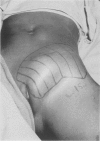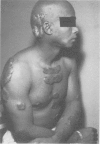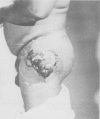Abstract
The wide range of oncogenic proliferative potentials of the fibroblast is demonstrated with a series of eight patients. Diagnoses included infantile digital fibromatosis, "aggressive fibromatosis," aggressive fibromatosis progressing to poorly differentiated sarcoma, infantile myofibromatosis, recurrent desmoid tumor, fibrosarcoma arising in a keloid, dermatofibrosarcoma protuberans, and malignant fibrous histiocytoma of left atrium. Still other types of fibroblastic tumefactions might have been included. Oncogenic factors that may have been operative in the causation of the lesions presented include: genetic factors, sex-linked factors, hormonal factors, numerous growth factors, and certain viruses, especially retroviruses. Certain fibromatoses in children are commonly self-limited and need only be monitored carefully as the process regresses. Aggressive fibromatosis, on the other hand, can prove fatal if the lesion is not completely resected with a wide margin and, occasionally, the process may become frankly malignant, with metastases. The standard triad of excisional surgery, radiotherapy, and chemotherapy has been used to treat frankly malignant fibrous tumors with variable results.
Full text
PDF









Images in this article
Selected References
These references are in PubMed. This may not be the complete list of references from this article.
- COHEN S. Isolation of a mouse submaxillary gland protein accelerating incisor eruption and eyelid opening in the new-born animal. J Biol Chem. 1962 May;237:1555–1562. [PubMed] [Google Scholar]
- Chung E. B., Enzinger F. M. Infantile myofibromatosis. Cancer. 1981 Oct 15;48(8):1807–1818. doi: 10.1002/1097-0142(19811015)48:8<1807::aid-cncr2820480818>3.0.co;2-g. [DOI] [PubMed] [Google Scholar]
- Crichlow R. W., Girardi A. J., Ravdin R. G. Homologous growth of human fibroblasts in varying stages of simian virus-40 transformation. Surg Forum. 1965;16:227–229. [PubMed] [Google Scholar]
- Goustin A. S., Leof E. B., Shipley G. D., Moses H. L. Growth factors and cancer. Cancer Res. 1986 Mar;46(3):1015–1029. [PubMed] [Google Scholar]
- James R., Bradshaw R. A. Polypeptide growth factors. Annu Rev Biochem. 1984;53:259–292. doi: 10.1146/annurev.bi.53.070184.001355. [DOI] [PubMed] [Google Scholar]
- Jones I. T., Jagelman D. G., Fazio V. W., Lavery I. C., Weakley F. L., McGannon E. Desmoid tumors in familial polyposis coli. Ann Surg. 1986 Jul;204(1):94–97. doi: 10.1097/00000658-198607000-00014. [DOI] [PMC free article] [PubMed] [Google Scholar]
- LEVI-MONTALCINI R. Effects of mouse tumor transplantation on the nervous system. Ann N Y Acad Sci. 1952 Aug 8;55(2):330–344. doi: 10.1111/j.1749-6632.1952.tb26548.x. [DOI] [PubMed] [Google Scholar]
- Lacey S. W. Oncogenes in retroviruses, malignancy, and normal tissues. Am J Med Sci. 1986 Jan;291(1):39–46. doi: 10.1097/00000441-198601000-00008. [DOI] [PubMed] [Google Scholar]
- Mackenzie D. H. The fibromatoses: a clinicopathological concept. Br Med J. 1972 Nov 4;4(5835):277–281. doi: 10.1136/bmj.4.5835.277. [DOI] [PMC free article] [PubMed] [Google Scholar]
- Purdy L. J., Colby T. V. Infantile digital fibromatosis occurring outside the digit. Am J Surg Pathol. 1984 Oct;8(10):787–790. doi: 10.1097/00000478-198410000-00008. [DOI] [PubMed] [Google Scholar]
- Reitamo J. J., Scheinin T. M., Häyry P. The desmoid syndrome. New aspects in the cause, pathogenesis and treatment of the desmoid tumor. Am J Surg. 1986 Feb;151(2):230–237. doi: 10.1016/0002-9610(86)90076-0. [DOI] [PubMed] [Google Scholar]
- Roses D. F., Valensi Q., LaTrenta G., Harris M. N. Surgical treatment of dermatofibrosarcoma protuberans. Surg Gynecol Obstet. 1986 May;162(5):449–452. [PubMed] [Google Scholar]
- Venn G. E., Gellister J., DaCosta P. E., Goldstraw P. Malignant fibrous histiocytoma in thoracic surgical practice. J Thorac Cardiovasc Surg. 1986 Feb;91(2):234–237. [PubMed] [Google Scholar]
- Weiss S. W., Enzinger F. M. Malignant fibrous histiocytoma: an analysis of 200 cases. Cancer. 1978 Jun;41(6):2250–2266. doi: 10.1002/1097-0142(197806)41:6<2250::aid-cncr2820410626>3.0.co;2-w. [DOI] [PubMed] [Google Scholar]









